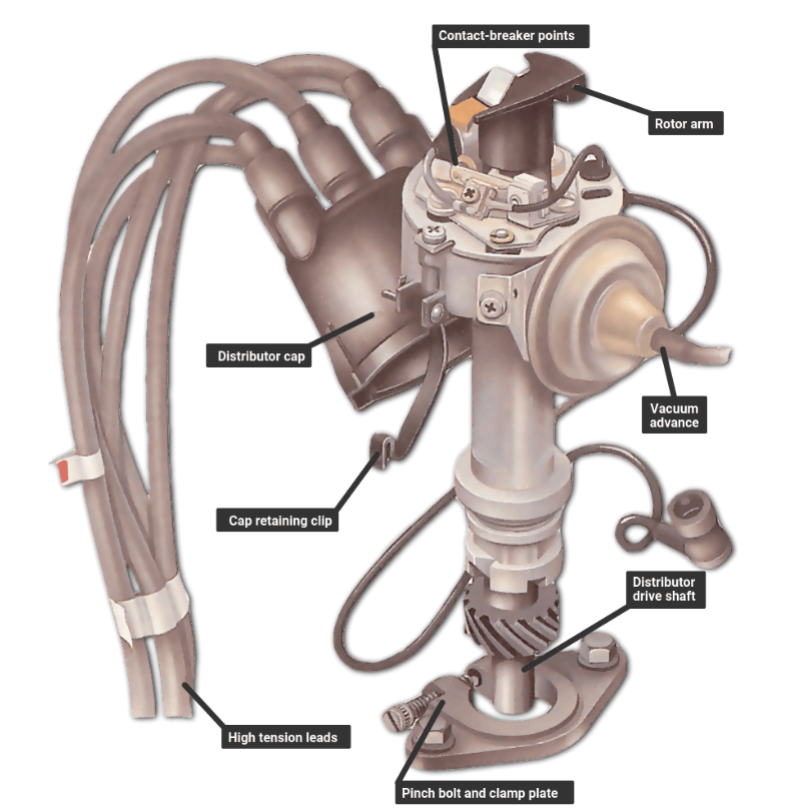
Distributor is a part of the ignition system, which can control the switch of the primary circuit and distribute the spark to the spark plug of each cylinder in order. The distributor is mainly used in the conventional ignition system and the common electronic ignition system, but these two ignition systems have been basically eliminated. Now the automobile engine parts eliminate the distributor.
Working principle of distributor
In the battery ignition system, the distributor and the breaker are usually on the same shaft and driven by the valve camshaft. It also has ignition advance angle adjustment device and capacitor, etc. Breaker arm in distributor closes the contact with a spring leaf and opens the contact with breaker cam. The opening clearance is about 0.30~0.45 mm. The number of bulge in breaker cam is the same as the number of cylinders. When contact point is opened, the distributor's arm is aligned with the corresponding side electrode, and the high voltage generated by induction is transmitted from the secondary winding to the corresponding spark plug in the cylinder, transmitted by the distributor arm, side electrode and high tension lead.
What is a distributor
The distributor is a part of the ignition system, which controls the switch of the primary circuit and distributes the spark to the spark plug of each cylinder in order. The distributor is mainly used in the conventional ignition system and the electronic ignition system, and these two ignition systems have been eliminated.

What does a distributor consist of
There are many forms of distributors, but the structure and working principle are basically the same. They are all composed of signal generator, distributor and centrifugal ignition advance device.
1. Signal generator
The function of the signal generator is to generate signal voltage and output to the ignition controller, which controls the work of the ignition system. According to their different working principles, signal generators can be divided into magnetic induction type, hall type, photoelectric type, the first two types are commonly used.
2. Distributor
The distributor is installed on the upper part of the signal generator, which is composed of the distributor cap and rotor. Its function is to distribute the high-voltage current to the spark plug according to the ignition sequence.
Distributor cap is made of bakelite powder pressed in steel mold, mounted on the top of distributor and fixed with cap retaining clips. The distributor cap is arranged on the top of the distributor shaft, which rotates with the shaft and is provided with a conducting metal sheet. In the middle of the distributor cap is a socket hole for high tension lead. which is provided with a carbon column with a spring and pressed on a conductive plate of the distributor cap. The distributor cap is surrounded by side electrodes, which is equal to the number of engine cylinders passing to the cap. The metal socket hole on the cap is inserted into the spark plug wire. When the cam is rotating, the conductive plate passes through the gap between 0.2-0.8mm from the adjacent electrode. When the signal generator generates the ignition signal, the high voltage jumps from the conductive plate to the opposite side electrode, and then is sent to the spark plug through the spark plug wire.
3. Ignition advance device
There is a time process from ignition to combustion, and the role of the optimal ignition advance angle is to make the maximum gas expansion trend in power stroke under various working conditions. This has the highest efficiency, the lowest vibration and the lowest temperature. The factor that has the greatest influence on the ignition advance is the rotation speed. With the increase of the rotation speed, the spinning time of the same angle becomes shorter, and only a larger advance angle can get the corresponding advance timing. Adjusting the correct ignition timing is called "ignition timing". In addition to the initial ignition advance angle set when installing distributor, the engine can also automatically adjust the ignition timing according to the speed, load and other factors. The automatic ignition timing can be divided into centrifugal advance, vacuum advance and computer control advance.
(1)Centrifugal advance
When the engine speed increases, the centrifugal blocks of centrifugal force increases gradually, since a certain speed, the centrifugal blocks of centrifugal force to overcome the spring tension, make the outward centrifugal blocks off, centrifugal blocks on the pin push the plate with a camshaft, make open cam in advance contact, ignition and one angle of a degrees in advance. The higher the rotational speed is, the greater the centrifugal force of the centrifugal block is, the greater the degree of centrifugal block is off, and the greater the ignition advance angle is. It satisfies the requirement that the ignition advance angle increases with the increase of rotation speed.
(2) Vacuum advance
Many engines control the ignition advance angle by using the vacuum at the small hole in the carburetor base. At idle speed, the hole is above the throttle, the degree of vacuum at the hole is tiny.
(3) Computer control in advance
The computer sends information about engine operation through various sensors, calculates the correct ignition timing, and the primary current of ignition coil is cut off. The computer controls the ignition timing based on the engine temperature, information from the knock sensor, in addition to engine speed and load.
 James Smith
James Smith  July 30, 2020
July 30, 2020